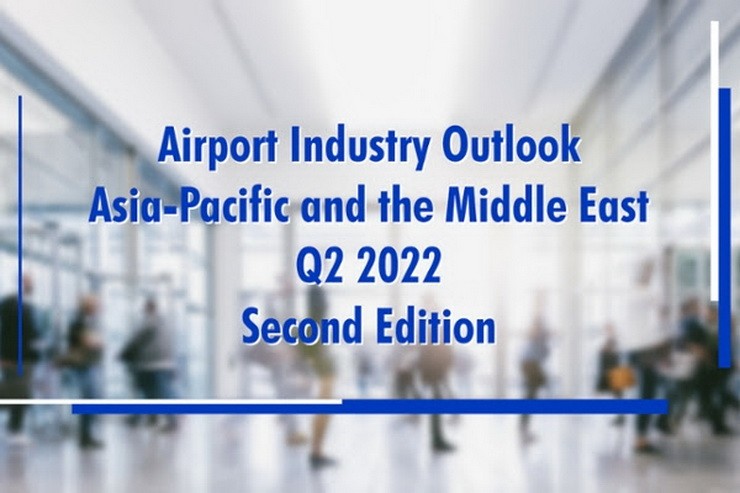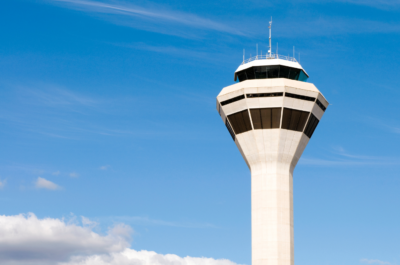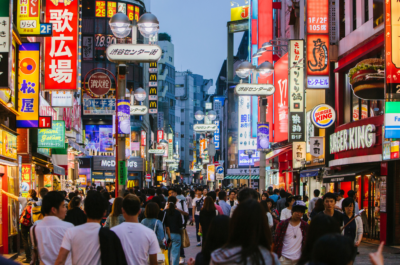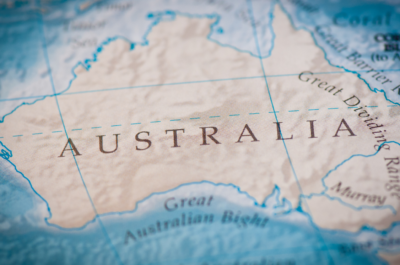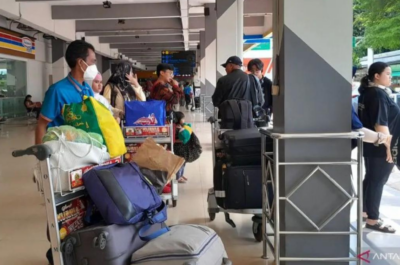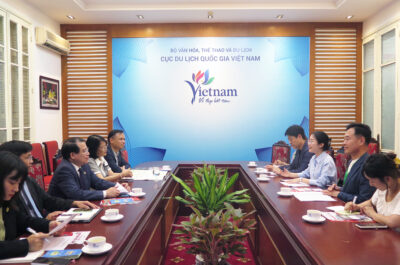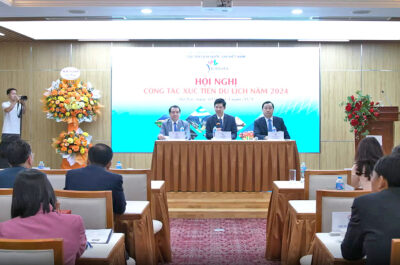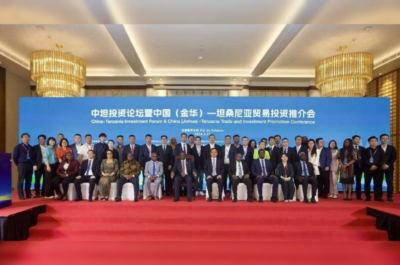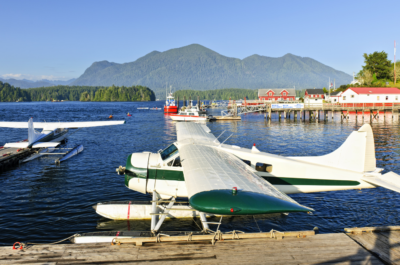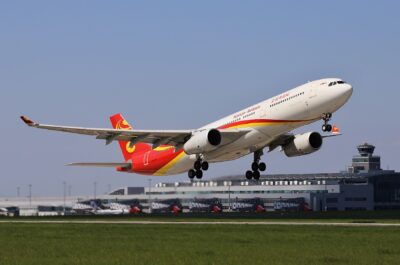Airport financial margins remain far below pre-pandemic levels.
Hong Kong – There has been cautious sense of optimism for the aviation sector following the relaxation of travel restrictions and successful vaccination programmes in many parts of Asia-Pacific and the Middle East, according to the Airports Council International (ACI) Asia-Pacific’s Industry Outlook.
The Industry Outlook for the second quarter of 2022 (April to June), developed in partnership with Mott MacDonald, provides a snapshot of airport business performance across the region with a short-term analysis of the key industry trends.
Overview
Following a turbulent first quarter, marked with rigid travel restrictions, suspension of international air travel in some parts of the region and geopolitical conflict, the recovery in the Asia-Pacific and Middle East regions are benefiting from a strong pent-up demand. Despite signs of improvement, the industry still faces strong headwinds, including geopolitical instability in eastern Europe and its subsequent impact on the global macroeconomics, including high inflation, rising energy prices and disruptions in supply chains. All these external factors, to a certain extent, continue to negatively impact the supply and demand for air travel.
ACI Asia-Pacific Director General Stefano Baronci, said: “As a result of a successful vaccination campaign that covers an average of 74% of the population across the region, travel restrictions are being gradually phased out across the region, fuelling strong demand for air travel. Though 2022 looks to be a more positive year for the sector, there will be bumps in our road to recovery especially in consideration of the uncertain macroeconomic scenario. As part of our efforts to further enhance airports’ role of engines of economic and social progress in a safe and sustainable manner, ACI Asia-Pacific, at the recent ICAO 57th Conference of Directors General of Civil Aviation for Asia and Pacific Regions in Incheon, Republic of Korea, urged the regulators to work closely with the industry to enhance manpower and operations to ensure a smooth traveller experience and harmonise as much as possible health protocols. ACI Asia-Pacific will continue to work with our members to help the industry build back stronger.”
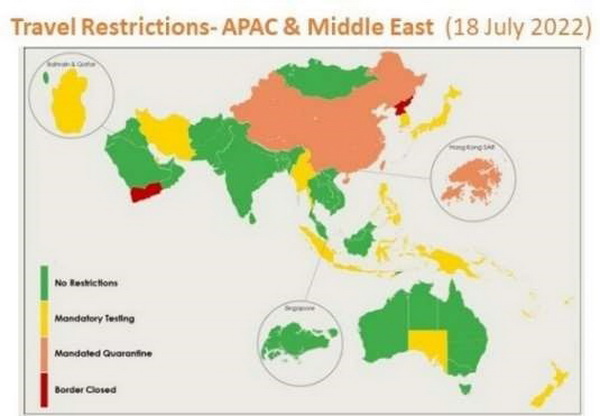
Positive Indicators
On a positive note, several other indicators look promising for the sector that has been battered by the COVID-19 pandemic over the last two years. Easing of stringent travel protocols is driving the recovery of traffic. The quarter saw countries such as Cambodia, Singapore, India, Thailand, Malaysia and Australia withdrawing restrictions on international air travel. Statistics from key hubs in these countries show that, in aggregate, passenger traffic has increased substantially between the end of February and early July 2022.
While South Asia (Bangladesh, Bhutan, India, Nepal, Pakistan, Sri Lanka, Maldives and Afghanistan) and the Middle East (Bahrain, Kuwait, Oman, Saudi Arabia, UAE, Iraq, Iran, Jordan, Yemen, Qatar) have recovered to approximately 85% of Q2 2019 seat capacity, Emerging East Asia (China, Mongolia and Democratic People’s Republic of Korea) is at just 15% of 2019 Q2 level as China adopted a ‘ZeroCovid’ approach and renewed lockdowns. Most of East Asian countries are heavily dependent on Chinese passengers.
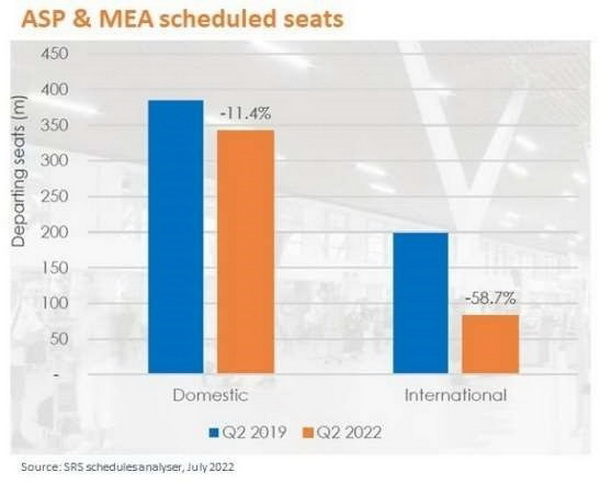
Pent-up demand for air travel particularly for leisure such as visiting friends and relatives and postponed holidays, will continue to buoy the industry’s recovery even as the sector faces strong headwinds against inflation and geopolitical risks. Many airports are already operating at capacity in peak periods, even though the overall footfall is below 2019 levels.
The Q2 2022 scheduled domestic seat capacity shows recovery of 89% of pre-pandemic levels as compared to the same quarter of 2019. The international seat capacity, however, is still down 59% as travel restrictions, quarantine and testing requirements still continue to impact, particularly in China and partially in Japan. Total domestic seat capacity is expected to exceed 2019 levels by Q3 2022, with the overall traffic for the year 2022 likely to be on par with 2019 levels.
Cargo Traffic
Cargo markets in Asia-Pacific and Middle East continued to remain robust, driven by a resurgence of air cargo volumes in China and the re-routing of Europe-Asia cargo through Middle Eastern hubs to avoid Russian airspace. Recent improvements in supply chain constraints and the easing of COVID restrictions in China are expected to ease market conditions and drive demand for air cargo. The index based on actual cargo tonnage indicates that in Q1 2022, air cargo volumes are above Q1 2019 levels across the majority of sub-regions. The sub-regions with the largest cargo shares in the region are Emerging East Asia (China, Mongolia &, Democratic People’s Republic of Korea) at 32%, followed by Developed East Asia (Japan, Republic of Korea, Chinese Taipei, Hong Kong & Macau) at 30% and Middle East (Bahrain, Kuwait, Oman, Saudi Arabia, UAE, Iraq, Iran, Jordan, Yemen & Qatar) at 16% and Southeast Asia (Brunei, Cambodia, East Timor, Indonesia, Laos, Malaysia, Myanmar, Philippines, Thailand, Vietnam & Singapore) at 15%.
Airport Revenues and Expenditures
Despite an improving trend, airport financial margins continue to remain far below pre-pandemic levels and are economically unsustainable. Quarterly revenues remain 60% below 2019 which is a similar level compared to 2021, indicating that revenues continue to remain at unsustainably low levels, leading to large operating losses incurred by airports. Total operating expenditures have declined in Q1 2022 compared to 2019 and while this decline has narrowed slightly compared to Q1 2021. This demonstrates that airport operators are making efforts to limit expenditures.
Workforce At Airports
Airports in the Middle East and Asia-Pacific are carefully handling the risk of deficit of workforce at airports. Compared to Europe and other parts of the world, airports in Asia-Pacific and Middle East Airport have experienced to a lesser extent manpower shortage, which is not just limited to airports but to the entire aviation ecosystem, including Airlines, Government agencies, ground handling, security and check-in etc. This was mainly due to two concurrent factors: the long-term vision of several airports to retain their staff despite the challenging time; and to the moderate recovery of traffic compared to other regions in the World. With reference to the latter, Asia-Pacific is expected to have the slowest recovery, reaching only 62% of 2019 levels in 2022. This is giving our airports and other aviation stakeholders time to address the challenges and simultaneously work on introducing digital technologies and reskilling and upskilling staff, providing a better career development to make airports a more attractive place for long-term career.
Theodore is the Co-Founder and Managing Editor of TravelDailyNews Media Network; his responsibilities include business development and planning for TravelDailyNews long-term opportunities.













